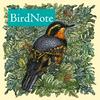1307 episodes

What Makes an Efficient Flying Bird?
2025-12-25 | 1 mins.
Every bird species uses its wings a little differently, and some are specialized for highly efficient flight. But that means going without other abilities. Swallows and hummingbirds, like a Talamanca Hummingbird, capture their food on the wing, but they can’t walk. Swifts, which are acrobatic in the air, can’t even perch. Yet they dazzle with the maneuverability made possible by their aerodynamic bodies.More info and transcript at BirdNote.org.Want more BirdNote? Subscribe to our weekly newsletter. Sign up for BirdNote+ to get ad-free listening and other perks. BirdNote is a nonprofit. Your tax-deductible gift makes these shows possible. Hosted by Simplecast, an AdsWizz company. See pcm.adswizz.com for information about our collection and use of personal data for advertising.

Birds Move from Fresh to Salt Water
2025-12-24 | 1 mins.
To hear a Common Loon in the wild during summer, you’ll need to find a northern, freshwater lake where a pair is nesting. But to find that same Common Loon in winter, you’ll likely need to look on a saltwater bay. This shift from fresh to salt water would kill most animals. But loons — along with many ducks and other water birds — have evolved to make that move. It’s possible that breeding adults nest on fresh water in order to save their energy for raising chicks.More info and transcript at BirdNote.org.Want more BirdNote? Subscribe to our weekly newsletter. Sign up for BirdNote+ to get ad-free listening and other perks. BirdNote is a nonprofit. Your tax-deductible gift makes these shows possible. Hosted by Simplecast, an AdsWizz company. See pcm.adswizz.com for information about our collection and use of personal data for advertising.

Birdsong and Solitude
2025-12-23 | 1 mins.
The Wall of Birds at the Cornell Lab of Ornithology is a towering mural showing nearly 250 life-sized birds across a map of the world. To complete the impressive artwork, artist and scientific illustrator Jane Kim spent 17 months painting day in and day out. Though the experience was often solitary, Jane stayed connected to the outside world through the sounds of wildlife in the nature preserve that surround Cornell Lab.Read more about Jane Kim and the Wall of Birds in Field Notes!More info and transcript at BirdNote.org.Want more BirdNote? Subscribe to our weekly newsletter. Sign up for BirdNote+ to get ad-free listening and other perks. BirdNote is a nonprofit. Your tax-deductible gift makes these shows possible. Hosted by Simplecast, an AdsWizz company. See pcm.adswizz.com for information about our collection and use of personal data for advertising.

Letter to a Dark-eyed Junco
2025-12-22 | 1 mins.
Writer and ornithologist J. Drew Lanham shares a note he has written to a Dark-eyed Junco, which he fondly nicknames “snowbird.”More info and transcript at BirdNote.org.Want more BirdNote? Subscribe to our weekly newsletter. Sign up for BirdNote+ to get ad-free listening and other perks. BirdNote is a nonprofit. Your tax-deductible gift makes these shows possible. Hosted by Simplecast, an AdsWizz company. See pcm.adswizz.com for information about our collection and use of personal data for advertising.

Why Birds Eat Snow
2025-12-21 | 1 mins.
In the depths of winter, when open water is frozen over, it can be challenging for birds to stay hydrated. Some birds eat the frozen water all around them. Cedar Waxwings catch snowflakes in mid-air. Black-capped Chickadees drink from dripping icicles. Plenty of other birds scoop up fresh, powdery snow and eat it. It could be worth the calories to melt the snow when searching for liquid water could expose them to predators.More info and transcript at BirdNote.org.Want more BirdNote? Subscribe to our weekly newsletter. Sign up for BirdNote+ to get ad-free listening and other perks. BirdNote is a nonprofit. Your tax-deductible gift makes these shows possible. Hosted by Simplecast, an AdsWizz company. See pcm.adswizz.com for information about our collection and use of personal data for advertising.
More Education podcasts
Trending Education podcasts
About BirdNote Daily
Listen to BirdNote Daily, The Mel Robbins Podcast and many other podcasts from around the world with the radio.net app

Get the free radio.net app
- Stations and podcasts to bookmark
- Stream via Wi-Fi or Bluetooth
- Supports Carplay & Android Auto
- Many other app features
Get the free radio.net app
- Stations and podcasts to bookmark
- Stream via Wi-Fi or Bluetooth
- Supports Carplay & Android Auto
- Many other app features


BirdNote Daily
download the app,
start listening.































